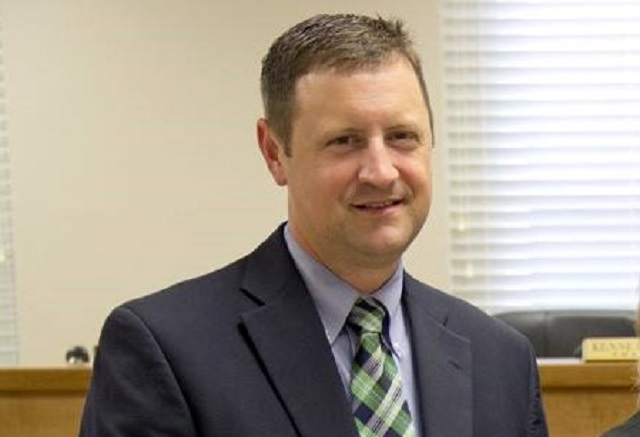Chris Van Dyke, executive director of the Cullman Mental Health Authority/Mental Healthcare of Cullman
CULLMAN – For our last installment on mental health and the frightening 2017 suicide surge in Cullman County, the Tribune spoke with Chris Van Dyke, executive director of the Cullman Mental Health Authority/Mental Healthcare of Cullman (CMHA) about how the mental healthcare system works here and around north Alabama.
In response to the recent rash of suicides, Van Dyke was open about the confusion. He explained how suicide is a multifaceted problem with no simple explanation.
"It's tragic," he began. "I really don't know what's going on. I don't remember ever having anything like this. We're all looking for answers, and there's not really one clear answer; which is what research shows. Suicide is very complex; so many factors go into it. We haven't been able to point to anything specifically that's happening."
The first article in this series presented a list of risk factors and warning signs of impending danger. Of these factors, Van Dyke pointed out that people cannot often simply point to one to define a victim's problem.
"A lot of times, it's a combination of factors,” he explained. “One thing that we see very commonly: somebody has an addiction problem; and you mix that together with a job loss or a relationship problem- fighting in the household, boyfriend-girlfriend, or parent-child- put those two things together and sometimes the likelihood of a suicide goes way up. It's usually a combination of factors, for sure."
Van Dyke took a moment to make some general observations about suicide trends in the area around Cullman County (No specific cases were discussed; privacy laws limit a healthcare provider's ability to talk, and the Tribune will not ask.), not necessarily just this year.
He stated, "We don't have a lot of insight into what happened with most of these cases. What I can say is this: the overwhelming majority of suicides in Cullman County are people who are not receiving treatment. That tells me that getting treatment does help."
Van Dyke did not attempt to claim that treatment is a guaranteed solution for all patients, but that it does help many who seek it out.
Psychology: art vs. science
According to Van Dyke, “Mental healthcare is different from the rest of healthcare. We don’t have a blood test that says ‘This is what your diagnosis is.’ A lot of what we are able to do is based on what the person tells us. That’s definitely a weakness.
“If somebody is intent on not telling us something, there’s sometimes no way for us to know. But we do try to pick up on all the signs available.
“Let me say this: talking, actually verbalizing thoughts of suicide is, in my opinion, the most important step for somebody to take. Whether it’s to a mental health person or not, telling somebody, ‘I’m feeling like killing myself’ takes it outside of just being inside your head, and makes it much easier to deal with, and to see in a realistic way, to see other options. It’s when people keep it inside their heads and make plans that nobody knows, that things are really dangerous.
“That happens more often than you think, especially with men. Men have a much higher rate of completion of suicide; women have a higher rate of feeling suicidal, but they’re more likely to talk about it and less likely to act on it. Men are more likely to plan and not tell a soul.”
When CMHA gets a call from a person contemplating suicide
Van Dyke offered a detailed explanation:
"There's several options. If this is during the daytime to the Access to Care line, then they can walk in that day, or they can go to the hospital. You'd be surprised, but sometimes people call and say they're feeling suicidal, yet they want to schedule an appointment; they don't want to come today. So, we do that, if that's what they want to do. But we do see people as walk-ins.
"If it's after hours, we're going to talk them through, try to learn more about the situation: who's with them, are there weapons present, that sort of thing, go through the risk factors. A lot of times, if somebody is really sounding suicidal, we're going to ask them to go to the emergency room."
When CMHA gets a call from a family member or friend
"We're going to talk to them about the commitment process," shared Van Dyke. "If you want to have somebody involuntarily evaluated, what you do is come here (CMHA) during the day and file a report called a Report of Concern. That report lays out what you're seeing. Then one of our master’s level staff is going to sit down with them and go over that report, and talk through it, try to figure out all the things that are going on and how we might best be able to intervene.
“We don’t want to involuntarily intervene if there’s any other way. Just the fact of sending the police to somebody’s house and having them brought in in the back of a car, that’s traumatic and it ties up the hospital every time you do that. So, we walk through the options. If there doesn’t seem to be an option to get them treatment voluntarily, then we send that report of concern to the probate court and they turn it into an official petition for commitment. Once there’s a petition, the sheriff’s deputies pick that person up and take them to the emergency room, and we evaluate them there.”
As to the span of time involved in this procedure, Van Dyke stated that CMHA tries to get everything done the same day.
“The only time it can get too late is if they say the person’s not home today,” he explained. “We try to time it so we can actually get them soon.”
Once a patient is in the system
According to Van Dyke, “We always start off with an evaluation. In the hospital, it’s more about ruling out any medical conditions; then we talk through the current situation, the crisis at hand, to try to determine: do they need to be held involuntarily? Do they meet that criteria?
“We also try to talk to people in the hospital about getting voluntary treatment. Sometimes that’s very effective. Once somebody sees ‘I’m going to get treatment whether I agree to it or not,’ they agree to go voluntarily. And that’s good.
“Here in the office, we try to do a more full assessment we call the Bio-Psycho-Social Assessment. We’re looking at your medical history, we’re looking at your family history, we’re looking at your mental health history; and we walk through all those factors to try to come up with a diagnosis.
“Once we have a diagnosis, then we establish a treatment plan. That may be just counseling, it may be counseling and seeing a psychiatrist, it may be a day program or addiction program. We have all of those available.”
Long-term and short-term care
For persons in danger, who cannot be helped effectively though outpatient programs, certain residential treatment options may be available; but access is often limited.
Van Dyke walked us through the details of long-term and short-term facility care:
“Our entire system is very limited in both short-term and long-term care, and becoming more and more so. If someone is admitted to a psychiatric hospital, they’re going to be there as short a time as possible; because of the pressure on the system to take hurt people, and reimbursement issues that hospitals run into. Whether that person has insurance or not, the hospital has to get them out to outpatient treatment as fast as possible. And the determination in a lot of cases, especially suicide, is what the person says.
“Every time they see the doctor, the question’s going to come up, ‘How are you feeling? Are you feeling suicidal now?’ It doesn’t take very many days of ‘I’m feeling better now’ til they’re making discharge plans and it’s time to go home. The length of stay varies quite a bit, but it all hinges on what the person is reporting to the hospital, for short-term stays.
“Really, the only time you have long-term stays these days is if there’s a commitment. It’s a little bit longer term, because there’s less pressure to move people through. But there’s still pressure, because those beds are limited, as well.”
Van Dyke reported that north Alabama has 64 beds in four long-term facilities: Cullman (CMHA), Jasper, Anniston and Huntsville. Each facility has 16 beds. Additionally, many people are familiar with Bryce Hospital in Tuscaloosa (whose famous old facility was replaced in recent years by an updated but smaller facility); finding space there can be quite frustrating.
Van Dyke said, “Bryce Hospital has a waiting list. North Alabama, we’re sort of allotted 20 beds, but there’s a waiting list, and we don’t even have 20 people in there. Right now, there’s about eight or nine out of our 20, and we usually have two or three people waiting to go. If someone is too severe to go to one of our units, then they go on that list to go to Bryce.”
The length of stay in the CMHA long-term facility averages around 40 to 50 days. Bryce tends to keep patients longer, as it typically gets patients with more specialized needs. The typical person threatening suicide, though, will not be sent to Bryce.
The biggest weakness in the north Alabama mental health system
Van Dyke did not shy away from the question:
“It’s kind of two-pronged; it’s hard for me to choose between acute care (crisis response and short-term care) and long-term care. They’re both equal needs. We need more acute care, because people are waiting in the emergency room for days to go to a psychiatric bed. It’s about how those beds are paid for. Medicaid pays for psychiatric stays, but there are so many people who have nothing, that the hospitals end up closing beds, because they can’t afford it. They’re overwhelmed by people who have no pay source.
“If there were a way to pay for those beds, there would be more. But because there is no way, they have to close them, so those people have to wait.
“And we need more long-term care because we have people who need to be in a group home, but there are no group homes they can go to. The group homes that we have are full from people coming out of Bryce and the commitment units. But there are people who need a group home who haven’t even been to them. We need both sides of that equation.”
Advice to Alabama’s Legislature
Van Dyke was direct and to the point:
“They’ve got to quit ignoring mental health. People think that it’s an issue that doesn’t touch most of the population; I hear that all the time. But it does: it either touches your family or a neighbor’s family.
“But then it has impacts on law enforcement, on the hospital and the ER, DHR, schools; it touches everything. I keep trying to make the point to people: mental health treatment is part of the infrastructure of the community, just like having a hospital or a school system. They really need to see it that way, and they don’t. That’s what I’d say.”
If there was to be a bill put before the legislature this session, what should be the first item on it?
“There is a push already on, started with NAMI (National Alliance for Mental Illness) at a summit in Birmingham a few weeks ago. They were pushing for restoring the funding cuts that have been made over the past eight years. Then, on top of that, they were looking for money to expand the service I was talking about, both acute and long-term. All totaled up, it was like $68.9 million.”
Advice to a person in danger
“The most important thing,” said Van Dyke, “is to talk about it. Not hint, but actually say to someone, ‘I’m feeling like killing myself.’ That can be a family member, friend, crisis line, us, a pastor; it needs to be somebody. Verbalize it, talk about it. Then make sure that you stay in a safe environment. Don’t spend a lot of time isolating; stay with people. Remove any weapons or drugs that might be tempting or a threat. We have our local crisis line available 24/7 (256-737-2000, an on-call system operated by CRMC). Just say, ‘I need mental health,’ and they’ll page whoever’s on call. There’s also the national hotline (1-800-273-TALK).”
Advice to a family member or friend
“I would say, confront your concerns with the person. If they (friends and family) want to call here and talk about it, we’re happy to talk to them. Our Access to Care office (256-255-1020) has been getting an extraordinary number of calls this year, and that’s good; that’s what we want. If you call and don’t get them right away, leave a message, and they’ll call you right back. They can give you advice and help figure out what the best course of action is.”
Further reading:
"A short-term solution to a long-term problem": Sheriff Gentry weighs in on mental health issues: http://www.cullmansense.com/articles/2017/02/17/short-term-solution-long-term-problem-sheriff-gentry-weighs-mental-health-issues
CCBOE staffers talk about mental health resources: http://www.cullmansense.com/articles/2017/02/16/ccboe-staffers-talk-about-mental-health-resources
Interview with Cullman Police Chief Kenny Culpepper: http://www.cullmansense.com/articles/2017/02/09/cullman-city-police-chief-kenny-culpepper-addresses-local-mental-healthcare-and
Remembering Nate: Interview with local suicide victim’s parents: http://www.cullmansense.com/articles/2017/02/09/remembering-nate-parents-local-suicide-victim-open-about-impact-loss
Cullman sees frightening increase in numbers of suicides: http://www.cullmansense.com/articles/2017/02/02/cullman-co-sees-frightening-increase-suicides
Copyright 2017 Humble Roots, LLC. All Rights Reserved.


















